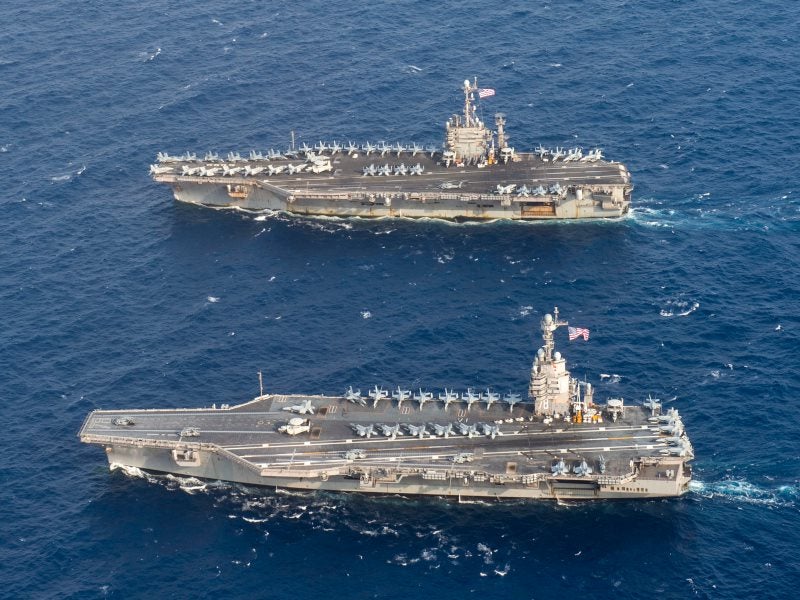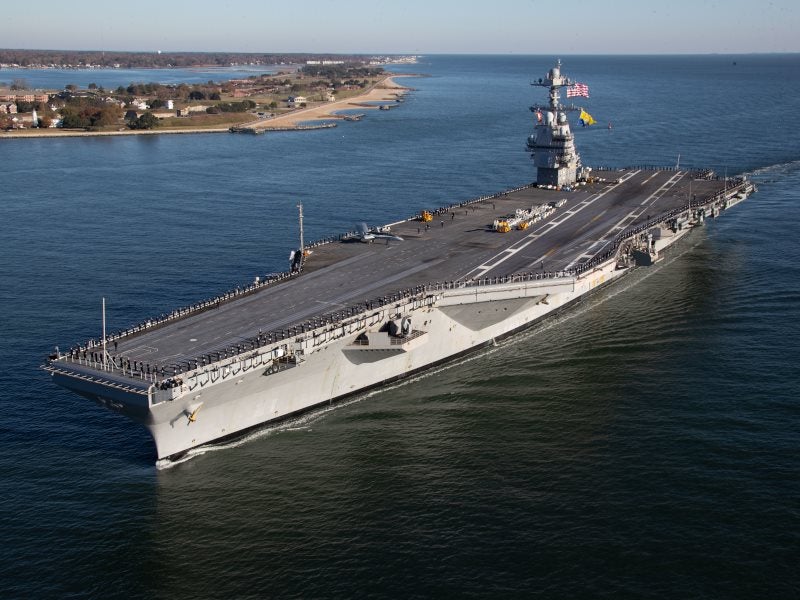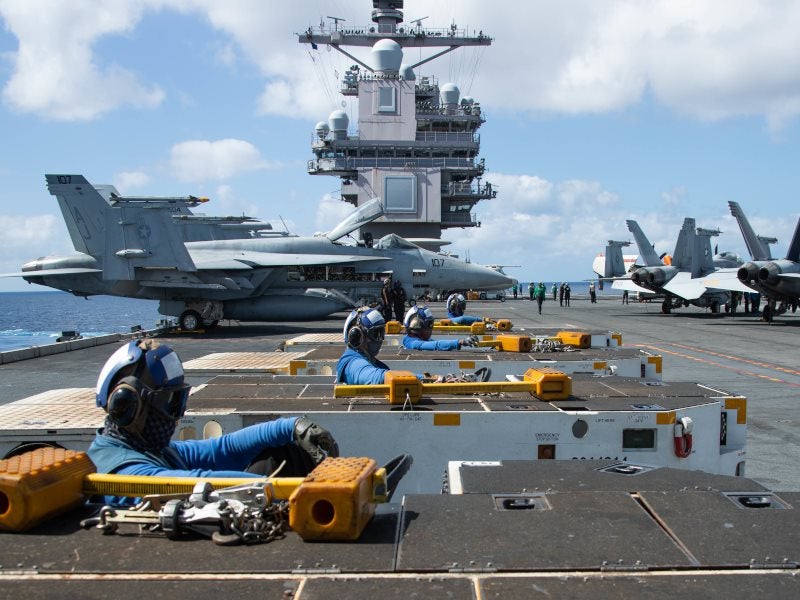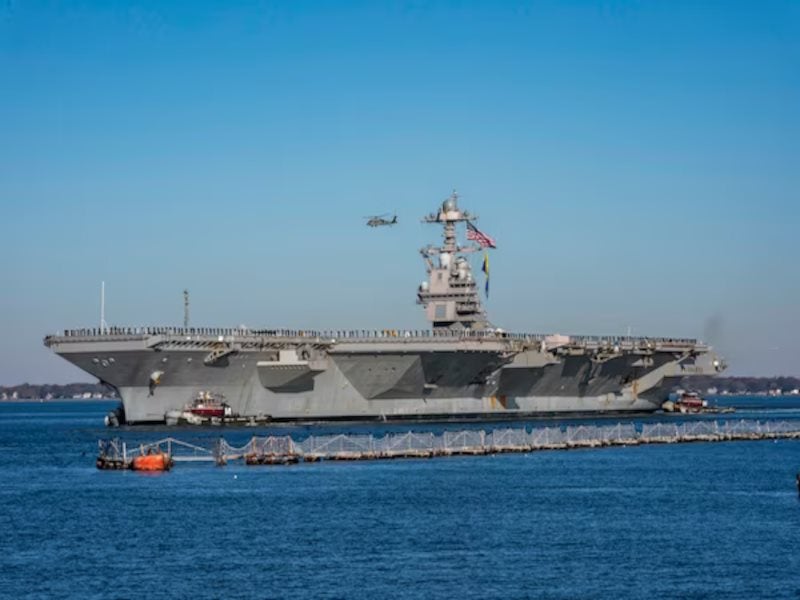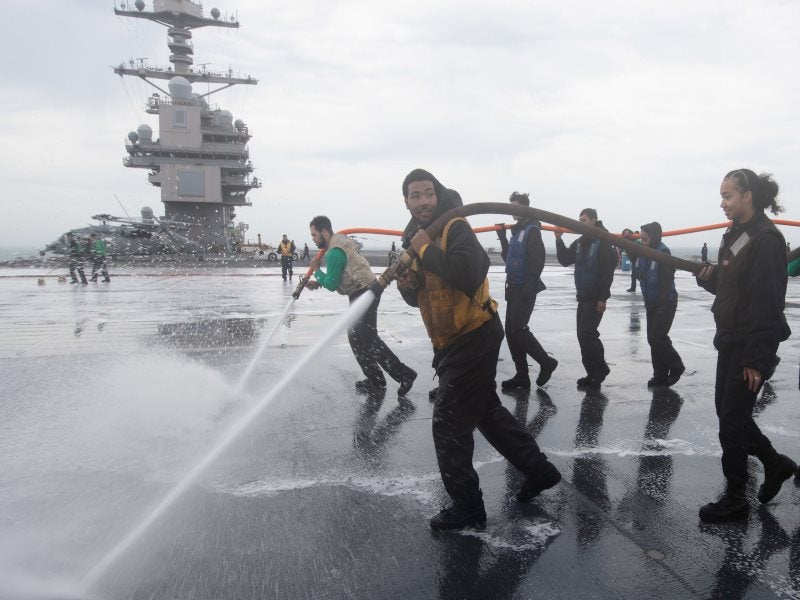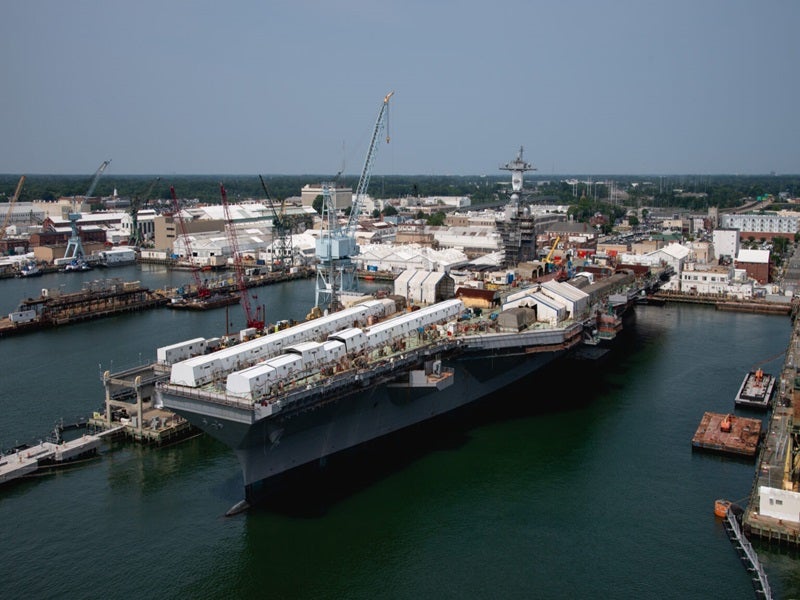The Gerald R. Ford-class is a fleet of nuclear-powered aircraft carriers (CVNs) being developed by the Newport News Shipbuilding (NNS) division of Huntington Ingalls Industries (HII) for the US Navy under its CVN-21 Aircraft Carrier Program.
In January 2007, the US Navy announced that the new class of vessels would be called the Gerald R. Ford-class.
The first four ships in the Gerald R. Ford class are the USS Gerald R. Ford (CVN-78), USS John F. Kennedy (CVN-79), USS Enterprise (CVN-80), and USS Doris Miller (CVN-81).
The USS Gerald R. Ford was delivered to the US Navy in May 2017 and commissioned in July 2017. The aircraft carrier completed a multiweek final deployment composite training unit exercise for certification as a combat-deployable US warship in April 2023.
The ship replaced the USS Enterprise (CVN 65), which was decommissioned after more than five decades of active service in 2017.
Gerald R. Ford-class aircraft carriers design details
With a displacement of approximately 100,000 tons (t), the Gerald R. Ford-class is larger than its predecessor, the Nimitz-class, but accommodates between 500 and 900 fewer crew members.
The Ford-class ships will feature 23 new or upgraded systems compared to the Nimitz-class carriers.
The Gerald R. Ford-class carriers have a length of 333m, a beam of 40.8m, and a flight deck width of 78m.
The reduction in manpower was a key performance parameter added to the original four outlined in 2000 in the operational requirements document for the CVN 21 programme.
It is estimated that the new carrier technologies will lead to a 30% reduction in maintenance requirements and a further crew workload reduction will be achieved through higher levels of automation.
Other main differences in operational performance compared with the Nimitz-class are increased sortie rates at 160 sorties a day (compared with 140 a day), a weight and stability allowance over the 50-year operational service life of the ship, and an increase of approximately 150% in electrical power generation and distribution to sustain the ship’s advanced technology systems.
Another key performance requirement is interoperability.
Gerald R. Ford class vessel development details
The first steel for the USS Gerald R. Ford was cut in August 2005. The keel was laid in November 2009.
The aircraft carrier was fitted with four 30t bronze propellers in October 2013. Both the launch and first voyage of the ship took place in November 2013.
Anchor testing on board the carrier was completed in June 2014 while the US Navy conducted electromagnetic aircraft launch system (EMALS) testing on the aircraft carrier in May 2015. The ship returned to NNS for post-delivery works in July 2018.
Construction of the USS John F. Kennedy began in February 2011 and its keel was laid in July 2015.
It was christened and launched in December 2019.
In June 2023, NNS received contract modifications totalling $393.3m to adjust the delivery strategy for the USS John F. Kennedy. Under the revised plan, the carrier is now scheduled to be delivered to the US Navy by July 2025.
The first steel was cut for the USS Enterprise aircraft carrier in August 2017. It is built using the steel of CVN 65, which was decommissioned in April 2018.
It is the ninth ship to be named USS Enterprise and will replace USS Dwight D Eisenhower, which is expected to be decommissioned in 2029.
The keel-laying ceremony for the USS Enterprise took place at the NNS shipyard in August 2022. The ship is expected to be delivered by September 2029.
The first steel for the USS Doris Miller was cut in August 2021. The keel for the ship is expected to be laid in 2026 and the ship is scheduled to be delivered in February 2032.
Gerald R. Ford-class aircraft carrier hull
Since the 1960s, all US Navy aircraft carriers have been built at NNS. The company extended its design and shipbuilding facilities with a new heavy-plate workshop and burners, a new 5,000t thick plate press, covered assembly facilities and a new 1,050t-capacity crane.
NNS is using a suite of computer-aided design tools for the CVN 21 programme, including a CATIA software suite for simulation of the production processes and a Cave virtual environment package.
The hull design is similar to that of the current Nimitz-class carriers, with the same number of decks. The island is smaller and positioned further towards the aft of the ship.
The island features a composite mast with planar array radars, a volume-search radar operating at S-band and a multifunction radar at X-band.
It also carries a stern-facing joint precision approach and landing system, which is based on the local area differential GPS rather than radar.
The aircraft carrier traditionally carries the flag officer and 70 staff of the carrier battle group. The flag bridge, which was previously accommodated on the carrier’s island, was relocated to a lower deck to reduce the size of the island.
The ship’s internal configuration and flight deck designs have changed significantly. The lower decks incorporate a flexible, rapidly reconfigurable layout, enabling various layouts and the installation of new equipment in command, planning and administration areas.
The requirement to build in a weight and stability allowance will accommodate the added weight of new systems that will be installed over the 50-year operational life of the ship.
The removal of one aircraft elevator unit and the reduction in the number of hangar bays from three to two contributed to a weight reduction of the vessels.
Sensors
In October 2008, Raytheon was contracted to supply a version of the dual-band radar (DBR) developed for the Zumwalt-class destroyer, for installation on the Gerald R. Ford. DBR combines X-band and S-band phased arrays.
Propulsion
Northrop Grumman developed an advanced nuclear propulsion system with two reactors, four shafts, and a zonal electrical power distribution system for the carriers.
Gerald R. Ford-class aircraft carrier performance
The carrier can carry up to 90 aircraft, including the F-35 Joint Strike Fighter, F/A-18E/F Super Hornet, E-2D Advanced Hawkeye, EA-18G Growler electronic attack aircraft, MH-60R/S helicopters, as well as unmanned air and combat vehicles.
The requirement for a higher sortie rate of 160 sorties per day, with surges up to a maximum of 220 sorties per day during times of crisis and intense air warfare, led to design changes in the flight deck.
The flight deck features a relocated, smaller island and three deck-edge elevators instead of four. Deck extensions also increase the aircraft parking areas, and aircraft service stations are located near the 18 refuelling and rearming stops.
The aircraft carriers are equipped with General Atomics’ Systems Group’s (GA-EMS) Electromagnetic Aircraft Launch System (EMALS), which uses a linear electromagnetic accelerator motor. The EMALS replaces the current C-13 steam catapults traditionally used on vessels to launch aircraft, expanding the aircraft launch envelope for future manned or unmanned aircraft.
EMALS technology offers the potential benefit of finer aircraft acceleration control, which leads to lower stress levels in the aircraft and pilots, provides a slower launch speed for unmanned air vehicles, and allows a wider window of wind-over-deck speed required for the launch sequence.
The ships are also equipped with advanced arrestor gear (AAG). The electromagnetic motor applies control to the synthetic arrestor cable to reduce the maximum tension in the cable and decrease the peak load on the arrestor hook and the aircraft fuselage.
Weapons onboard Gerald R. Ford-class carriers
The Gerald R. Ford-class carriers can be armed with the Raytheon-evolved Sea Sparrow missile, which defends against high-speed, highly manoeuvrable anti-ship missiles.
The close-in weapon system is the rolling airframe missile from Raytheon and Ramsys.
Aircraft weapon loading
The flow of weapons to the aircraft stops on the flight deck was upgraded to accommodate the higher sortie rates.
The ship carries stores of missiles and cannon rounds for fighter aircraft, bombs and air-to-surface missiles for strike aircraft, and torpedoes and depth charges for anti-submarine warfare aircraft.
Weapons elevators transport the weapons systems from the magazines to the weapons handling and assembly areas on the 02-level deck (below the flight deck), and express weapons elevators are installed between the handling and assembly areas and the flight deck.
The US Navy outlined a requirement for a minimum increase of 150% in the power-generation capacity for the CVN 21 carrier compared with the Nimitz-class carriers.
The increased power capacity is required for the four electromagnetic aircraft launchers and for future systems such as directed energy weapons that may become feasible during the carrier’s 50-year lifespan.
Contractors involved
The US Department of Defense awarded NNS a $107.6m contract in July 2003 and a $1.39bn contract in May 2004. The department also provided $559m to prepare for the carrier construction and continue the design programme on the ship’s propulsion system.
A $5.1bn contract for the detailed design and construction of USS Gerald R. Ford was awarded to NNS in September 2008.
NNS won a contract to support further repair work on the lead ship. The contract covers execution planning for the repair and alteration requirements of the ship’s planned incremental availability.
Northrop Grumman was awarded a planning and design contract for the second carrier, USS John F. Kennedy, in November 2006.
The two companies selected by Northrop Grumman to design the advanced weapons elevator for the ships are Federal Equipment Company and Oldenburg Lakeshore.
NNS was awarded a $407m contract extension for the preparation work on the USS John F. Kennedy ship in March 2013 and a $1.29bn extension in March 2014. It also received a $3.35bn contract for the ship’s detailed design and construction in June 2015.
NNS was awarded a $152m contract in May 2016 for the advanced planning engineering, design, and procurement of long-lead-time material for the third ship of the class, USS Enterprise.
A $25.5m modification contract was awarded for advance fabrication of the aircraft in February 2017.
NNS received a $15.2bn contract modification in January 2019 for the detailed design and construction of the USS Enterprise and USS Doris Miller.
Naval equipment provider Fairbanks Morse received a contract to supply emergency diesel generator sets for the USS Enterprise and USS Doris Miller carriers in February 2019.
Timken, a manufacturer of bearings and power transmission products, announced that its Philadelphia Gear division had secured a contract exceeding $100m from HII-NNS in February 2021.
The contract involves supplying the main reduction gears for the USS Doris Miller aircraft carrier.
In June 2023, GA-EMS received a contract modification from Naval Air Systems Command to supply EMALS and AAG for USS Doris Miller.
In September 2024, QinetiQ US, a defence and national security firm, secured a contract from GA-EMS to provide control hardware and software for the EMALS and AAG to be installed on the USS Doris Miller.

